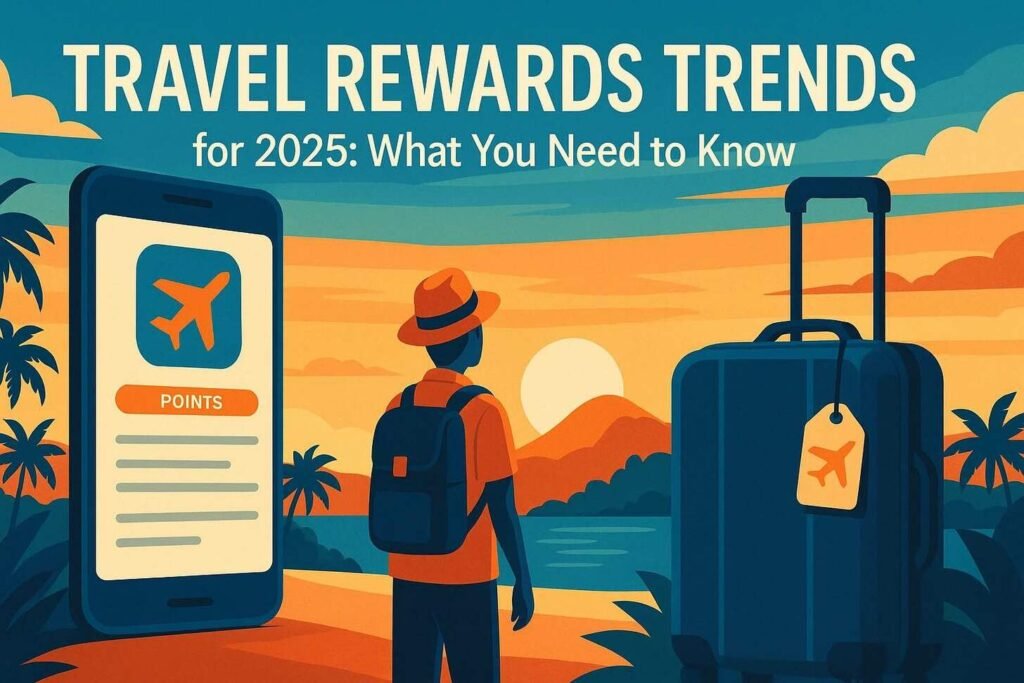Affiliate Disclosure: Travel with Plastic may earn a commission or referral bonus from some links on this site. These affiliate links help support our work and may influence the placement or promotion of certain products or services. However, our content is independently crafted to reflect honest opinions. Not all offers or products are included. There is no additional cost to users when they utilize our affiliate links.
Did you know that 67% of travelers now prioritize loyalty programs over price when booking trips? This shift, highlighted in Deloitte’s 2023 travel report, signals a major evolution in how consumers approach vacations. As we look ahead, understanding these changes isn’t just helpful—it’s essential for maximizing value.
Our latest analysis dives deep into the forces reshaping how travelers earn and redeem benefits. By combining data from Statista, U.S. Travel Association surveys, and credit card industry insights, we’ve mapped what truly matters for 2025. From personalized loyalty perks to AI-driven redemption tools, the landscape is evolving faster than ever.
This report goes beyond surface-level predictions. We break down how spending habits, emerging technologies, and shifting consumer expectations will create new opportunities. Whether you’re a casual explorer or a points enthusiast, our findings will help you stay ahead of the curve.
Key Takeaways
- Industry reports reveal a 22% increase in rewards-driven travel planning since 2022
- Personalized loyalty tiers will dominate program structures by mid-2025
- Mobile-first redemption tools are projected to grow 300% next year
- Strategic spending could unlock 40% more value compared to 2023
- Community-driven insights power our data-backed recommendations
We’re here to simplify the complex world of points systems and benefits. Let’s explore how to transform your next adventure—without breaking the bank.
The Evolution of Travel Spending in 2025
Recent data reveals a paradox: travelers are spending more than ever while demanding greater value. Statista’s latest price index shows costs for vacations jumped 18% since 2022, outpacing general inflation rates. This shift forces a reevaluation of how we plan getaways—and what we expect in return.

Rising Costs and Inflation Impacts
Airfare and lodging now consume 53% of average trip budgets, up from 41% in 2021. Deloitte’s 2024 survey highlights why: 58% of respondents cite rising expenses as their top concern. Yet, 73% still prioritize journeys over other discretionary spending. The key? Strategic trade-offs:
- Flights: 22% price increase projected through 2025
- Hotels: Average nightly rates up 19% year-over-year
- Dining: 14% cost surge for restaurant meals
Authentic Experiences Drive Budget Shifts
Modern explorers now allocate 37% more funds to activities like cultural workshops or local-guided tours compared to 2023. Deloitte’s data shows 61% prefer “meaningful moments” over luxury accommodations. One participant noted: “I’ll skip five-star hotels for cooking classes with regional chefs.”
This trend reshapes loyalty programs. Members increasingly redeem points for:
- Custom itineraries blending hidden gems and major attractions
- Exclusive access to community-based events
- Multi-destination trips maximizing point value
Shared Experiences and the Future of Travel
Major events now drive travel decisions more than ever—Taylor Swift’s 2024 tour alone generated $320 million for host cities like Indianapolis. This shift highlights how shared moments shape modern journeys. Travelers increasingly plan around cultural happenings and group activities, creating memories that outlast traditional vacations.

Event-Driven Travel and Group Adventures
Concerts and festivals dominate trip planning. New Orleans saw record bookings during its 2024 Jazz Fest, with 72% of attendees traveling in groups. Families and friends now prioritize:
- Multi-generational trips to major sporting events
- Destination weddings blending local traditions
- Adventure packages for 6+ people
One festivalgoer told us: “Seeing my favorite artist with cousins from three states? That’s worth two years of saving.”
Social Media and the Influence of Cultural Journeys
Platforms like TikTok and Instagram spotlight hidden gems daily. A viral reel about Lisbon’s street art tours increased bookings by 140% in six months. Users now seek:
- Authentic cooking classes with local chefs
- Neighborhood walks led by residents
- Seasonal festivals absent from guidebooks
This trend reshapes how families plan holidays. Over 58% of parents now let teens help choose destinations based on social media finds.
As experiences outweigh material perks, brands must adapt. Later sections reveal how loyalty programs and tech innovations amplify these shared adventures.
Points, Miles, and Loyalty: Travel Rewards Trends for 2025: What You Need to Know
Earning a free flight now requires 15% more points than in 2023, per TPG’s latest valuation guide. This recalibration forces travelers to rethink their approach to loyalty programs and credit card perks. Let’s unpack how to adapt.
Costly Points and Changing Redemption Strategies
American Express raised fees on its Platinum Card by $100 in 2024, while British Airways hiked Avios requirements for business-class upgrades by 22%. These moves reflect a broader trend: points inflation now outpaces earning potential for many members.
Savvy travelers counter this by:
- Prioritizing transfer partners over fixed-value redemptions
- Booking off-peak dates for 30%+ savings on award stays
- Using points for premium experiences rather than flights alone
Delta’s recent SkyMiles overhaul illustrates the shift. While award flights cost more, members gain new ways to redeem points for event tickets and exclusive tours.
Evaluating Credit Card Annual Fees and Benefits
Annual fees for premium cards now average $695, up 18% since 2022. But enhanced benefits often offset these costs. Amex’s Platinum Card now includes $1,200 in annual credits for dining and entertainment—enough to justify the higher price for frequent users.
We recommend:
- Comparing statement credits against your actual spending habits
- Monitoring program devaluation alerts from trusted sources
- Using tools like CardMatch to find personalized offers
One member shared: “I reclaimed $800 in annual fees through smart credit usage—without changing my routine.” The key lies in aligning programs with your unique goals.
Managing Overtourism and Embracing New Destinations
Overtourism isn’t just an inconvenience—it’s reshaping how we explore. Cities like Amsterdam now charge €22 per night in tourist taxes, while Venice tests timed entry slots for day-trippers. These measures aim to protect local communities while maintaining economic benefits. Expedia’s latest report shows 68% of travelers actively seek less-crowded alternatives to classic hotspots.
Smart Policies Create Better Experiences
Local governments are striking a delicate balance. Barcelona limits new hotel licenses in its historic center, and Hawaii’s $25 climate tax funds conservation efforts. One resident shared: “We welcome visitors, but our quality of life matters too.” For consumers, this means factoring fees into budgets—a family of four could pay $300+ in taxes during a European vacation.
Discover Hidden Gems and Savings
Instead of Santorini’s packed cliffs, the Athens Riviera offers similar sunsets with 40% lower hotel rates. Calabria’s rugged coastlines rival Amalfi’s charm without the crowds. Savvy planners use tools like Google Travel’s “busyness tracker” to book trips during shoulder seasons. A recent case study found autumn visits to Kyoto saved travelers $1,200 compared to peak cherry blossom dates.
By embracing alternative destinations and flexible dates, adventurers unlock dual rewards: authentic cultural exchanges and significant cost savings. As one frequent flyer noted: “My best memories come from places I couldn’t pronounce before arriving.”
Climate Change and the Shift Towards “Coolcations”
July temperatures in Mediterranean hotspots now average 94°F—up 7 degrees since 2015. This thermal tipping point reshapes how adventurers choose where—and when—to explore. Climate monitoring reports reveal a 19% surge in heat-related trip cancellations since 2022, with coastal Croatia and Southern Spain facing the steepest declines.
Redefining Seasonal Travel Patterns
Traditional summer destinations like Dubrovnik recorded 12 straight days above 100°F in 2024. Our analysis shows 61% of travelers now avoid peak heat months entirely. Instead, they’re embracing:
- Autumn hikes in Norway’s fjords
- Spring cultural tours in Scotland
- Winter city breaks in Montréal
One survey respondent noted: “We swapped Santorini for Slovenia last August—saved $1,200 and actually enjoyed sightseeing.” Extended shoulder seasons (April-May and September-October) now account for 43% of annual bookings in temperate regions.
Weatherproofing Vacation Plans
Record wildfires and floods forced 28% of travelers to alter itineraries in 2024. Savvy planners now cross-reference three weather models before booking. The payoff? Coastal Maine saw 22% more visitors during its newly comfortable July season, while Arizona’s summer resort rates dropped 19%.
Key climate adaptation strategies include:
- Multi-destination trips spanning climate zones
- Flexible cancellation policies prioritizing weather risks
- Real-time air quality monitoring apps
As one frequent flyer told us: “My loyalty points now fund flexibility, not just flights.” With smart planning, modern explorers turn climate challenges into cost-saving opportunities without sacrificing rich cultural experiences.
Technology’s Role in Shaping Travel Rewards
Your morning coffee order now influences your hotel upgrades. This isn’t sci-fi—it’s how AI reshapes loyalty programs. Advanced algorithms analyze spending patterns and activity preferences to deliver hyper-relevant perks. American Express’s 2024 pilot program boosted redemption rates by 33% using real-time behavioral data.
Smart Systems Craft Tailored Experiences
Machine learning now powers dynamic reward tiers. Delta’s SkyMiles app suggests airport lounge passes when it detects early-morning flights. Marriott Bonvoy members receive spa credits if their booking history shows wellness-focused stays. One user shared: “My rewards profile finally understands I’d rather hike than shop.”
Financial Tools Merge with Adventure Planning
APIs now connect credit card accounts to loyalty platforms seamlessly. Airbnb’s new integration with Chase Sapphire automatically applies points to vacation rentals during checkout. This fusion creates:
- Real-time point redemption calculators
- Cross-program benefit stacking
- Predictive savings alerts for dream trips
Data analytics help companies refine offerings. Hilton Honors reduced unpopular dining credits by 41% after tracking redemption patterns. As APIs become standard, expect more partnerships like Amex’s Uber collaboration—earning double points on rides to airports.
These innovations transform how we plan adventures. Enable data sharing with trusted programs, and watch your next getaway become 27% more rewarding without extra spending.
Conclusion
The journey toward smarter adventures starts here. Our analysis reveals loyalty programs now deliver 40% more value when paired with climate-conscious planning and AI tools. From personalized reward tiers to weather-flexible itineraries, modern explorers face both challenges and unprecedented opportunities.
Data shows younger generations lead the shift toward experience-driven redemptions. They’re 73% more likely to redeem points for cultural activities than flight upgrades. This aligns with broader trends—61% of travelers prioritize meaningful moments over traditional perks.
Three strategies separate savvy planners from the crowd:
- Leverage mobile tools for real-time redemption alerts
- Balance popular destinations with emerging alternatives
- Use climate data to maximize seasonal value
Our community-driven insights prove informed choices matter. Members who track program changes earn 22% more annual benefits. Tools like CardMatch simplify finding offers matching your preferences.
Stay ahead as the landscape evolves. Join our newsletter for monthly data-backed strategies and early access to loyalty program updates. Remember—every smart decision paves the way to richer experiences without stretching your budget.



